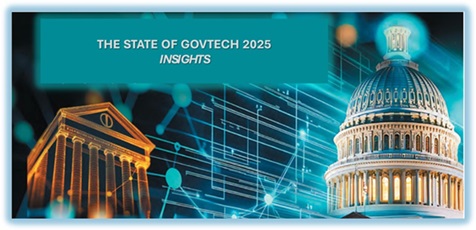
Enhancing Local Government Service Delivery with Govtech: A Conversation with Amanda Renteria, CEO, Code for America

I recently had the pleasure of hosting The Business of Government Hour at CivStart’s State of GovTech 2025. This event brought together government executives, technology leaders, startups, and academics to explore innovative solutions for local governments at the intersection of governance and technology. Among the many insightful conversations, my interview with Amanda Renteria, CEO of Code for America, stood out for its clarity on how technology is reshaping the relationship between cities and their residents. Our discussion highlighted practical approaches to modernizing government systems, the evolving govtech ecosystem, and the critical role of collaboration and experimentation in driving effective service delivery.
In this essay, I reflect on the key themes and insights from our conversation, exploring how technology informs governance and can shape a better future for local governments and communities.
The Mission of Code for America: Modernizing Government Systems
Local governments face mounting pressures such as aging infrastructure, budget constraints, and rising public expectations shaped by private-sector digital experiences. Amanda Renteria emphasized the critical role of technology in addressing these challenges.
Code for America’s mission centers on modernizing government systems. Over the years, the organization grew into one of the country’s leading civic tech nonprofit, partnering with government at all levels across the country to build digital tools, change policies, and improve programs.
Amanda noted that their mission is to ensure government services remain accessible and effective for all residents, even as technology transforms how these services are delivered. This involves rethinking outdated processes and leveraging digital tools to make government interactions more efficient and user-friendly. For instance, their work often targets legacy systems—aging technological infrastructures that hinder cities’ ability to deliver services effectively. By addressing these challenges, Code for America helps governments stretch limited resources without compromising service quality, a critical balance in today’s environment of economic uncertainty and reduced public investment.
One example Amanda shared was the Memphis Youth Jobs Platform, a technology hub designed to connect young people with career training and employment opportunities. Recognizing that younger generations prefer online platforms over traditional job fairs, Code for America built a mobile-friendly, community-oriented system that resonates with its users. The platform’s success stems from its human-centered design, which involved young people in the development process to ensure it met their needs. This approach not only delivered practical outcomes—like connecting youth to jobs—but also fostered trust by engaging community organizations as partners.
The Memphis project illustrates how technology can bridge gaps between government services and residents, creating systems that are both accessible and responsive.
Addressing Legacy Systems Through Iterative Implementation
A recurring challenge for city leaders is managing legacy systems that are often incompatible with modern demands. Amanda highlighted a shift in how governments approach technology implementation, moving away from large-scale, one-size-fits-all solutions to smaller, iterative pilots. This strategy allows cities to test tools in specific contexts, such as a single county, before scaling up. Piloting reveals issues with legacy systems that might otherwise go unnoticed, enabling governments to address problems incrementally. This approach also incorporates resident feedback through surveys, ensuring that solutions are refined based on real-world usage.
The iterative process aligns with an agile mindset, which Amanda described as a significant departure from traditional government practices. By starting small, cities can experiment with new tools without committing to costly overhauls, reducing risk while improving outcomes. For example, Code for America’s work with Salt Lake City and Georgia on an AI-powered PDF auditing tool demonstrates this approach. The tool scans government websites to identify PDFs that fail to meet accessibility standards, a critical issue given the billions of PDFs in use across government platforms.
By automating this process, the tool saves time and resources, allowing cities to comply with upcoming accessibility regulations efficiently. More importantly, it introduces government staff to AI’s potential, building familiarity with emerging technologies in a practical, low-stakes context.
Building Trust Through Transparency and Communication
Public trust is essential for effective governance, particularly during crises like natural disasters or economic downturns. Amanda emphasized that clear, proactive communication is a cornerstone of trust-building. Governments often lack robust marketing or information-sharing mechanisms, yet residents increasingly expect timely, transparent updates. Code for America’s experience during COVID-19 showed that bringing stakeholders together to solve problems collaboratively—whether through shared data systems or community forums—creates a sense of shared purpose. For instance, their work in crisis response, such as supporting LA County during wildfires or Houston during floods, demonstrated how technology can deliver critical services quickly when traditional systems falter.
Amanda also stressed the importance of honesty in deploying new technologies like AI. Rather than concealing the use of AI chatbots or automated systems, governments should clearly communicate their purpose and limitations. For example, Code for America’s tax filing tools include features that explain why certain questions are asked, addressing user skepticism and building confidence. This transparency is particularly vital as residents’ expectations, shaped by seamless private-sector digital experiences, continue to rise. During COVID-19, the ability to access services like driver’s licenses online shifted public perceptions of what government can achieve digitally.
Cities that prioritize clear communication and user-friendly systems can meet these expectations, strengthening the bond with their residents.
The Evolving Govtech Ecosystem: Collaboration and Best Practices
The govtech ecosystem is evolving, driven byproduct by collaboration between cities, states, and organizations like Code for America. Amanda explained that events like CivStart’s State of GovTech and Code for America’s annual summit facilitate the sharing of best practices, enabling governments to learn from one another. For example, during COVID-19, states like Colorado and Rhode Island tackled similar challenges in linking school and state data to deliver resources to children. By convening these stakeholders, Code for America helped amplify successful strategies, such as deduplicating data to streamline service delivery.
Collaboration extends beyond government-to-government partnerships. Amanda highlighted the growing openness to working with startups and small businesses, particularly as procurement contracts become shorter and more flexible. This shift allows cities to adopt innovative solutions from the private sector, which can serve as stopgaps or long-term tools.
The State of GovTech 2025 showcased such innovations, from voice and text-based communication tools to translation services that make government services more accessible.
These technologies enable cities to reach residents quickly, especially during crises, and adapt to changing needs driven by factors like shifting public expectations, budgetary constraints, and geopolitical dynamics.
Cultivating a Culture of Experimentation
To keep pace with technological advancements, city leaders must foster a culture of experimentation. Amanda pointed to the influence of younger mayors and officials who are more open to change, citing her experience in San Jose, where proximity to Silicon Valley encouraged innovative thinking. Leaders can drive experimentation by targeting specific areas for improvement—such as pothole reporting or permitting processes—and using dashboards to track progress transparently. These dashboards, which display real-time data on agency performance, hold governments accountable while informing residents about ongoing efforts.
Code for America’s iterative approach supports this culture by encouraging governments to test solutions on a small scale before scaling up. Amanda emphasized that elected officials must also adopt patience, recognizing that meaningful change often requires time and refinement. By embracing this mindset, cities can overcome risk-averse tendencies and explore new technologies, from AI-driven tools to mobile platforms, that enhance service delivery.
The Future of Govtech: A Transformative Decade Ahead
Looking ahead, Amanda described the current moment as a transformative one for government technology. Modernization efforts at the federal level are cascading to states and cities, fundamentally changing how agencies operate. Technology enables data sharing and inter-agency collaboration, making government services more integrated and responsive. For example, online systems and virtual city council meetings create a two-way street for resident engagement, moving beyond the limitations of physical infrastructure.
Conclusion
My conversation with Amanda Renteria at CivStart’s State of GovTech 2025 offers a compelling path forward for local governments seeking to harness technology for better service delivery. By modernizing legacy systems, embracing iterative implementation, and prioritizing transparent communication, cities can strengthen their relationship with residents. The evolving govtech ecosystem, fueled by collaboration and innovation, offers practical tools to address pressing challenges, from accessibility compliance to crisis response. As city leaders cultivate a culture of experimentation, they position themselves to meet rising public expectations and build resilient, responsive systems. Code for America’s work exemplifies how technology and governance can intersect to create a future where cities serve their residents more effectively, fostering trust and engagement in the process.



